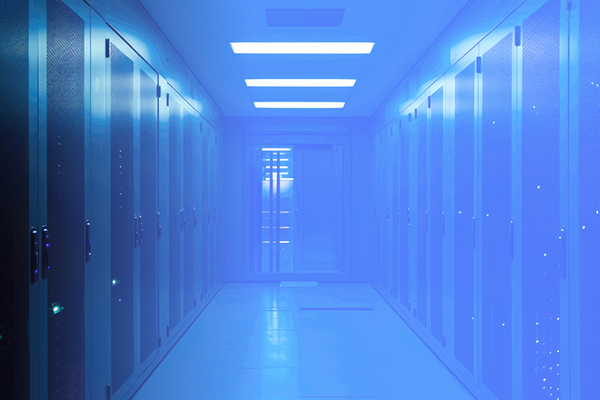Server room cooling
Server rooms need to be cooled to ensure the optimum performance and service life of the IT equipment located there. Here are some reasons why cooling a server room is essential.
Server rooms form the backbone of every modern IT infrastructure – stable cooling is crucial for trouble-free, secure and energy-efficient operation. Overheating can not only lead to failures, but also drastically shorten the service life of systems. Find out why well-designed cooling – even without traditional air conditioning systems – is crucial for the long-term success of your IT systems.
Prevent overheating
Servers and other IT devices generate a lot of heat. Without adequate cooling, the temperature can quickly rise to a level that could damage the hardware.
Ensure performance
Increase reliability
Extend service life
Energy efficiency
Minimize security risks
Power electronics uses special circuits (such as rectifiers, inverters, converters) and components (such as diodes, transistors, thyristors) to efficiently convert and control electrical energy. They enable applications such as motor controls, voltage conversions and energy networks to be operated efficiently and flexibly.
Conventional methods of cooling server rooms
A server room is air-conditioned using special techniques and equipment designed to control the temperature and humidity and dissipate excess heat. Here are the most important methods and components used for air conditioning a server room:
Air conditioning systems (CRAC units)
Computer Room Air Conditioners (CRAC) are specialised air conditioning units designed for use in server rooms. They regulate temperature and humidity and are designed for continuous operation.
Cold and hot aisle configuration
Server racks are set up in an arrangement in which cold and warm air flows are separated. Cold aisles are areas where cool air flows to the front of the racks, while hot aisles take the heated exhaust air from the rear of the racks and return it to the air conditioning system.
Raised Floor
A raised floor can be installed to distribute cold air evenly under the server racks. The cold air flows upwards through special openings or panels into the cold aisles.
In-Row Cooling
In-row cooling systems are located between the server racks and cool the air directly at the point where heat is generated. These systems are particularly efficient as they dissipate the waste heat directly.
Air cooling with air ducts
Air ducts can be used to direct cold air to the racks and efficiently remove warm air.
liquid cooling
Monitoring and control
Redundant systems
To increase reliability, redundant air conditioning and cooling systems are often installed. If a system fails, a backup system can take over the cooling.
Energy management
Efficient energy management and the use of energy-efficient cooling technologies help to minimize energy consumption and reduce operating costs.
A server room is air-conditioned using special techniques and equipment designed to control the temperature and humidity and dissipate excess heat. Here are the most important methods and components used for air conditioning a server room:

Server room cooling without air conditioning
Cooling a server room without the use of a traditional air conditioning system can be achieved using various methods of blower and ventilation technology. Here are some approaches that can be used:
Free cooling (Free Cooling)
With free cooling, outside air is used to lower the temperature in the server room. This can be done directly or indirectly:
• Direct free cooling: Outside air is fed directly into the server room after being cleaned by filters.
• Indirect free cooling: A heat exchanger is used to utilise the cool outside air without it entering the server room directly. This cools the indoor air without compromising the purity and humidity of the room air.
Air circulation and fan
The use of powerful fans can help to efficiently remove warm air from the server room and bring in cool air.
• Warm air extraction: Fans can be strategically placed to extract warm air from the server room and direct it outside.
• Cold air supply: Cool outside air can be fed into the server room via ducts and fans.
Air duct systems
A well-designed air duct system can optimize the circulation of cool and warm air.
• Cold and warm aisle separation: Server racks are arranged in such a way that cold and warm aisles are created. Cold air is directed into the cold aisles and warm air is extracted from the hot aisles.
• Roof fans: Roof fans can extract warm air from the server room and discharge it outside.
Adiabatic cooling
This technology uses the evaporation of water to cool the air.
• Evaporative coolers: Air is passed through wet filters or evaporative coolers, where the evaporation of the water cools the air. This cooler air is then fed into the server room.
Ground heat exchanger
A geothermal heat exchanger uses the relatively constant temperature of the ground to cool the air.
• Air-ground heat exchanger: Air is fed through underground pipes, where it is cooled by contact with the cooler ground before flowing into the server room.
Natural ventilation
Use of the natural air flow for cooling.
• Schornsteineffekt: Warme Luft steigt nach oben und kann durch Öffnungen im Dach entweichen, während kühlere Luft durch tiefer liegende Öffnungen nachströmt.
These methods can be used alone or in combination to achieve effective cooling of the server room without traditional air conditioning systems. It is important to consider the specific requirements and environmental conditions of the server room in order to find the best possible solution.

We will be happy to answer any questions you may have and look forward to hearing from you.
You can reach us Monday to Thursday from 8 a.m. to 5 p.m. and Friday from 8 a.m. to 2 p.m.
